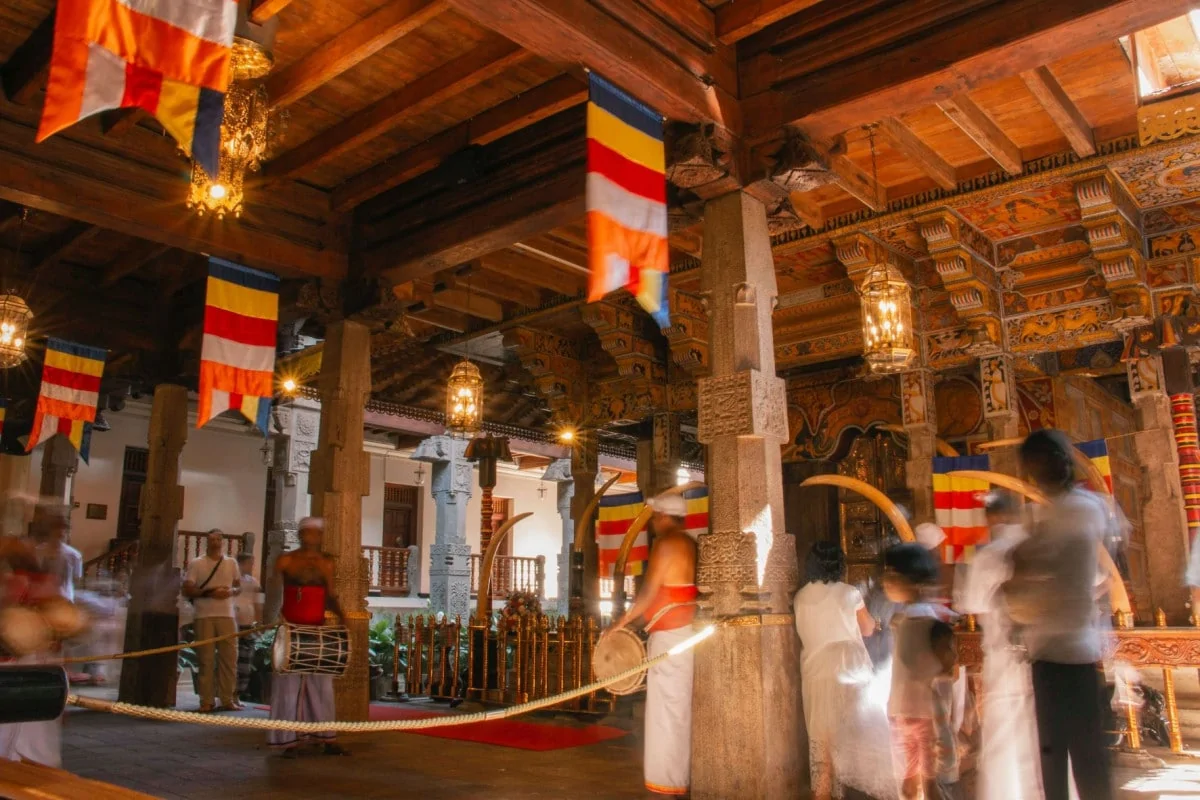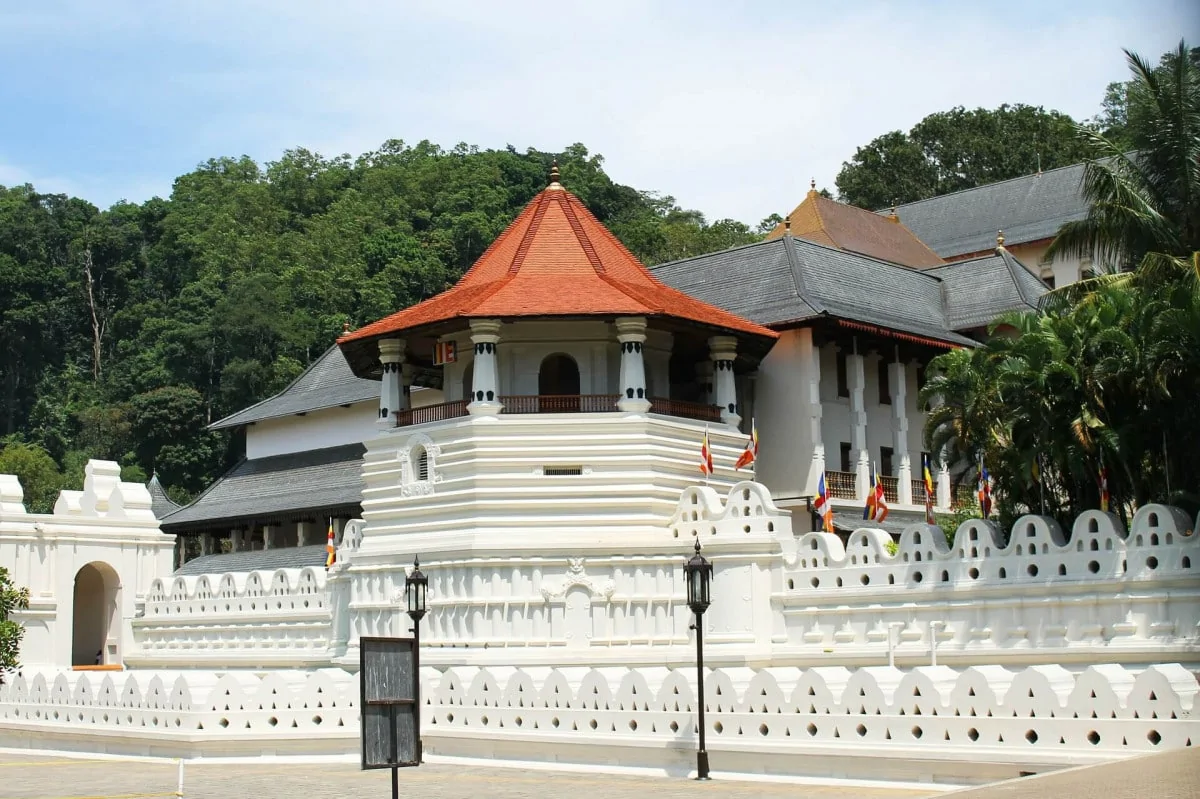Guarding the tooth of Lord Buddha safely within its walls, it’s no surprise that the Temple of the Tooth Relic or Sri Dalada Maligawa (which translates to Glorious Tooth Temple in the local language) is the star attraction in Kandy. A UNESCO World Heritage Site, the temple is considered the holiest of places in Sri Lanka for Buddhists. If you’re looking to explore this incredible temple we wanted to help you do just that; and so have put together everything you need to know in this: our Temple of the Tooth relic guide!

Skip ahead
History of The Temple Of The Tooth Relic
Though not as grand as some of the Buddhist temples found in Southeast Asia, the Temple of the Tooth Relic, with its white walls and red and black roofs, has an allure all its own and radiates a peaceful vibe despite the hundreds of devotees that throng its hallways every day.
Considered to be one of the most precious relics of Lord Buddha and a landmark in Sri Lanka, the temple’s history is filled with interesting stories and anecdotes.
The tooth, believed to be Lord Buddha’s left canine, is said to have been gathered from the ashes of the pyre where he was cremated in 543 BC in Kushinagar, India. Over the years, people started believing that the owner of the tooth would have indisputable rights to rule that land. Naturally, the tooth became an object worth possessing!

The tooth was moved out of India when a rival king attacked King Guhasiva of Kalinga (now known as Odisha, India) to procure the tooth. It is said that the tooth found its way to Sri Lanka, where Buddhism was well established, hidden in the hair of Princess Hemamali as she fled from India to safeguard it.
The tooth has moved many times, from the kingdom of Anuradhapura to Polonnaruwa to Dambadeniya to Gampola to Kotte. In fact, at a particular point during its exciting journey, the tooth was even hidden inside a grinding stone!
Many attempts have been made to steal the tooth. Early on, in 1603, the Portuguese tried to lay their hands on the relic. Later on, during 1635 – 1687, the Dutch burnt down the temple where the relic was housed.
As recently as 1989 and 1998, the Janatha Vimukthi Peramuna, a political party, and the LTTE, a militant organization in Sri Lanka, tried to bomb the Royal Palace.
Sri Vira Narendra Sinha, the last Sinhalese king of the Kingdom of Kandy, built the temple that you see today. The moat and the Paththirippuwa (the octagonal pavilion that is one of the three main buildings of the temple) were added later by Sri Vikrama Rajasinha. Former Prime Minister Ranasinghe Premadasa built the golden canopy that you see over the main shrine in 1987.
The temple is located in the Royal Palace Complex of the former Kingdom of Kandy. In fact, the tooth has always been kept close to the king’s residences. The reason is pretty obvious, isn’t it? The protection of tooth relic was considered the ruler’s duty, and its possession came to symbolize the right to rule.

Keen to see more of Sri Lanka? Check out our Sri Lanka itinerary.
The Esala Perahera Festival
The tooth has been attributed with other powers too. The story goes that once there was a terrible drought in the country, and the rain gods answered the people’s prayers only after the custodians took out the Tooth Relic on a seven-day procession. And that is how the Kandy Esala Perahera festival begun.
Also known as the ‘Festival of the Tooth,’ the event takes place in July and August every year. The tooth relic casket is kept on top of a male elephant and paraded through the streets of Kandy. Ornately decorated elephants, grand processions, lights, traditional dances, and more are part of the ten-day event, and it is probably the best time to visit if you want to immerse yourself in the culture of Kandy.

The Architecture of The Temple of the Tooth Relic
The Temple of the Tooth Relic is built in traditional Kandyan architecture style. One design element we noticed was the holes in the wall that runs along the moat and the lake. This has been designed for lighting oil lamps in the evening – a splendid sight!
Don’t be fooled by the rather plain exteriors. Once inside, you can’t help but notice the beautiful art and intricate wood, gold, silver, ivory, and bronze carvings. It was lovely to walk under artistically done hallways lined with colorful flags and brightly lit chandeliers,
The Tooth Relic is kept in a room on the upper floor of the temple. A grand door with elaborate ivory and silver carvings stands guard. Be warned that the tooth itself is not visible to the public. It is safely hidden inside a gold casket that contains six smaller caskets, all of which are ornately decorated. These caskets, located in the inner chamber, are shown to the devotees during puja (prayer) time. This happens thrice a day – in the morning, afternoon, and evening. Musicians in traditional costumes play the drum during the puja ceremony in front of the inner shrine guarded by huge elephant tusks.

If you can, we recommend visiting (or staying back) during puja time. It was a profoundly moving experience for us. Do also take the time to observe Buddhist monks and local folk dressed in white offer lotus blooms and frangipani to the shrine.
The Palace Complex at the Temple of the Tooth Relic
The Royal Palace is located to the North of the temple. A part of the Palace has been converted into an archaeological Buddhist museum. If you have some time, we suggest you visit the Aluth Maligawa area that houses many Buddha statues and interesting artifacts about the history of the Tooth Relic.
Kandy Lake sits to the South of the temple. Taking a walk around the lake was one of our favorite things to do – peaceful and calming!
There are several other museums, temples, and shrines that you can explore during your visit.
We loved the Elephant Rajah’s museum that puts the spotlight on Rajah, the elephant that was the bearer of the sacred casket during the Festival of the Tooth for a record 37 years, and participated in the celebrations for around 50 years! So loved was Rajah that the government even ordered a stamp and Rs.1000 note with his picture in his memory.

If you are interested in the history of the tooth relic, we recommend you stop by the Sri Dalada Museum that takes you through its journey.
How To Get To The Temple of the Tooth Relic
The Sacred Tooth Relic Temple complex is located in the heart of Kandy, around 2 km from the Kandy railway station.
You can visit the temple on a day trip from Colombo , and it takes around 3 hours to cover the distance. You can travel by bus (the most cost-effective option), train (a little more expensive but faster) or rent a two-wheeler or taxi.
Find all the transport options here on Bookaway.
What To Wear at The Temple of the Tooth Relic
Sri Lanka is a conservative country, and modest clothing is advised, especially when visiting a place of worship. Clothes covering your legs and shoulders are recommended. You’ll usually be asked to leave your shoes at the entrance to the temple.

Temple of the Tooth Relic Opening Hours and Prices
The temple is open year-round, and it’s open from 5.30 am to 8.30 pm. Puja timings are 5.30 am, 9.30 am and 6.30 pm.
The entrance fee for the temple is LKR 1,500 / 5.50 GBP / 7.50 USD.
Free audio tours are available at the ticketing office, or you can opt for a guide who will do a full tour of the royal complex.
Other things to do In Kandy
Hop on a tuk-tuk and ride the three temple loop that takes you to 3 of the most popular temples (after the Temple of the Tooth Relic, of course) in Kandy – the Gadaladeniya Viharaya, the Embekke, and the Lankathilaka
Measuring 88 feet tall, the Bahiravokanda Vihara Buddha Statue is the tallest in Sri Lanka. A trip to this Bahirawa Kanda hill also allows you panoramic views of the city.
The Botanical Garden of Kandy is just a 15-minute drive from the city and an absolute breath of fresh air. It’s a beautiful place to wander around and have a picnic. And the perfect place for memorable pictures!
Sri Lanka is known for its scenic train rides, and the Kandy to Ella train tops the list. Find a window seat or grab a space by the door and watch lush green tea plantations, gurgling streams, waterfalls, and verdant forests pass by. Pure bliss!

Where to Stay in Kandy
Luxury: If you want to splash out, then definitely consider Theva Residency. This gorgeous resort has breathtaking views (it’s very, very Instagrammable!) and is well-known for it’s on-site restaurant, if you’re a bit of a foodie.
Mid-range: Quite honestly we personally haven’t stayed at any great mid-range hotels that we could recommend. That said, we’re told that Elegant Hotel, a small boutique outfit, is a great option. It’s a bit on the outskirts of Kandy but apparently well worth the distance.
Budget: If you’re looking for a cool, sociable hostel, then Clock Inn is for you. It’s got dorms, private rooms and even 5 beautiful capsules on the balcony. A brilliant concept hostel, with all you can eat breakfast to boot!

Temple of the Tooth Relic FAQ
What is the Temple of the Tooth Relic?
The Temple of the Tooth Relic (Sri Dalada Maligawa) is a traditional temple in Kandy, Sri Lanka. Completed in 1595, it houses a tooth relic, believe to be Lord Buddha’s left canine from when he was cremated in 543 BC in India. The temple, a UNESCO World Heritage Site is located in the Royal Palace Complex.
What time does the Temple of the Tooth Relic open?
The temple (which is open year-round) opens each morning at 5.30am and closes at 8.30pm. Puja can be observed at 5.30am, 9.30am and 6.30pm.
What should I wear to the Temple of the Tooth Relic?
Whenever visiting religious temples, it’s always recommended to wear modest clothing. This is no different at the Temple of the Tooth Relic – visitors should cover their legs and shoulders in this place of worship.
About the Author: Gayathri Ranganathan
Gayathri is an accomplished travel writer, who loves to travel with her family – her teenage girls and her husband. She feels that ‘traveling is the best way to open up one’s mind and heart to different cultures, foods, and lifestyles.’ When she’s not traveling, she’s dreaming about traveling or busy researching some new destination. “Over the years, I’ve discovered that in life and travel, it’s always about the journey, never about the destination.”
Want to save this for later? Why not pin it…


